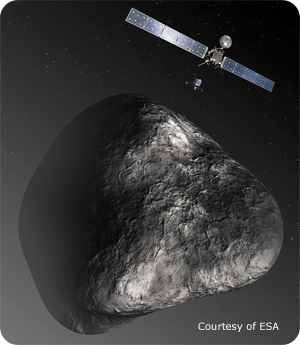The Rosetta space probe wakes up from deep space hibernation

The Rosetta space probe of the European Space Agency (ESA), launched in 2004, has sent back to the Earth the signal confirming that it has now emerged from its energy- and resource-saving deep space hibernation of two-and-a-half years on its voyage towards Comet 67/P Churyumov-Gerasimenko.
Two-and-a-half years ago Rosetta was placed in deep space slumber once it no longer received enough sunlight to produce electricity. During this period it has been crossing the coldest and loneliest part of its voyage, close to the orbit of Jupiter.
Rosetta’s mission is to carry out the first ever detailed investigation of a comet, observing it with its instruments while orbiting around it for two years. Rosetta will also deploy its soft touchdown lander 'Philae', equipped with ten instruments for making a detailed ‘in situ’ study of the surface of the comet’s nucleus.
After waking up, Rosetta now faces the most difficult and critical operations of its whole mission. In the coming months it will carry out some trajectory-tweaking maneuvers to get it back on course for comet approach and this will happen in August 2014. From that point on, Rosetta will be placed in orbit round the comet just as though it was a satellite circling the earth.
This whole set of complex activities will be controlled from earth by a team of engineers, with GMV playing a crucial role. It has sent some of its staff to the Rosetta Science Operations Centre within the European Space Agency’s European Space Astronomy Centre (ESAC/ESA) in Villafranca del Castillo (Madrid) and also to the European Space Operations Centre in Darmstadt. Among other activities, the support from Madrid comprises planning of scientific operations, planning control of the three instruments and preparation of the operations for the main mission phase (the comet phase). The personnel posted to Germany, for their part, are participating in the flight dynamics operations, specifically trajectory control and generation of the necessary commands for controlling the probe’s orbit and attitude, a responsibility dating right back to the launch in 2004. GMV also played a key part in the mission analysis phase from years before its actual blastoff.
Presence of GMV personnel in the European Space Agency’s European Space Astronomy Centre (ESAC/ESA) has been continuous since 1995. Since then our engineers have been giving operational support to practically all ESA missions in the areas of orbit control and determination, generation of commands and attitude determination.